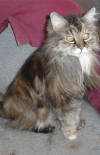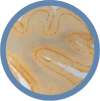Cognitive dysfunction in cats: a syndrome we used to dismiss as 'old age'
- PMID: 20974401
- PMCID: PMC11220932
- DOI: 10.1016/j.jfms.2010.09.004
Cognitive dysfunction in cats: a syndrome we used to dismiss as 'old age'
Abstract
Practical relevance: Cognitive dysfunction syndrome (CDS) is a widely accepted diagnosis in dogs, with established treatment options. In cats, however, our understanding of cognitive dysfunction is still being shaped by ongoing research in the field, and limited treatment options are available. Recent clinical studies indicate that old age in the cat is accompanied by increased behavioural signs such as wandering, vocalization and night-time activity that are not attributable to identifiable medical problems. It is essential, therefore, that veterinarians include behavioural well-being in the routine care of senior cats.
Patient group: While the exact age of onset is not established, studies suggest that age-related behavioural changes consistent with cognitive dysfunction are prevalent in cats as early as 10 years of age and that prevalence increases significantly in older cats.
Clinical challenges: The diagnosis of cognitive dysfunction requires the identification of geriatric behavioural changes that are not caused by other medical problems, although the two may not be mutually exclusive. Therefore, the practitioner must rely heavily on owner reports and history to ensure prompt diagnosis and treatment. The absence of any approved dietary or pharmaceutical interventions for cognitive dysfunction adds a further challenge, although several possibilities exist.
Evidence base: This article draws on recent research that has produced neuropathological, cognitive and behavioural evidence for cognitive dysfunction in aging cats. As an impetus to further our understanding of this disease and potential treatment options, the authors propose a behavioural checklist that might aid in the clinical diagnosis of feline CDS and discuss treatment options that have proven successful in the canine counterpart of this disease.
Copyright © 2010 ISFM and AAFP. Published by Elsevier Ltd. All rights reserved.
Figures










Comment in
-
Growing old is not for wimps.J Feline Med Surg. 2010 Nov;12(11):835-6. doi: 10.1016/j.jfms.2010.09.003. J Feline Med Surg. 2010. PMID: 20974400 Free PMC article. No abstract available.
Similar articles
-
Cognitive dysfunction in cats: clinical assessment and management.Top Companion Anim Med. 2011 Feb;26(1):17-24. doi: 10.1053/j.tcam.2011.01.005. Top Companion Anim Med. 2011. PMID: 21435622 Review.
-
Cognitive dysfunction syndrome: a disease of canine and feline brain aging.Vet Clin North Am Small Anim Pract. 2012 Jul;42(4):749-68, vii. doi: 10.1016/j.cvsm.2012.04.003. Epub 2012 May 17. Vet Clin North Am Small Anim Pract. 2012. PMID: 22720812 Review.
-
Cognitive dysfunction and the neurobiology of ageing in cats.J Small Anim Pract. 2007 Oct;48(10):546-53. doi: 10.1111/j.1748-5827.2007.00386.x. Epub 2007 Jul 6. J Small Anim Pract. 2007. PMID: 17617164 Review.
-
Cognitive Dysfunction in Cats: Update on Neuropathological and Behavioural Changes Plus Clinical Management.Vet Rec. 2021 Jan;188(1):e3. doi: 10.1002/vetr.3. Epub 2021 Jan 12. Vet Rec. 2021. PMID: 34651755 Review.
-
Behavior and Cognition of the Senior Cat and Its Interaction with Physical Disease.Vet Clin North Am Small Anim Pract. 2024 Jan;54(1):153-168. doi: 10.1016/j.cvsm.2023.09.001. Epub 2023 Oct 19. Vet Clin North Am Small Anim Pract. 2024. PMID: 37865588 Review.
Cited by
-
Blindness and behavioural changes in the cat: common neurological causes.J Feline Med Surg. 2011 Nov;13(11):863-73. doi: 10.1016/j.jfms.2011.09.007. J Feline Med Surg. 2011. PMID: 22063210 Free PMC article. Review.
-
Spontaneous mammalian models for Alzheimer's disease and dementia.Brain Commun. 2025 Jul 29;7(4):fcaf287. doi: 10.1093/braincomms/fcaf287. eCollection 2025. Brain Commun. 2025. PMID: 40799280 Free PMC article. Review.
-
Growing old is not for wimps.J Feline Med Surg. 2010 Nov;12(11):835-6. doi: 10.1016/j.jfms.2010.09.003. J Feline Med Surg. 2010. PMID: 20974400 Free PMC article. No abstract available.
-
Age-related brain atrophy in cats without apparent neurological and behavioral signs using voxel-based morphometry.Front Vet Sci. 2022 Nov 24;9:1071002. doi: 10.3389/fvets.2022.1071002. eCollection 2022. Front Vet Sci. 2022. PMID: 36504872 Free PMC article.
-
Determining priority welfare issues for cats in the United Kingdom using expert consensus.Vet Rec Open. 2019 Nov 2;6(1):e000365. doi: 10.1136/vetreco-2019-000365. eCollection 2019. Vet Rec Open. 2019. PMID: 31798909 Free PMC article.
References
-
- Landsberg GM, Hunthausen W, Ackerman L. The effects of aging on the behavior of senior pets. In: Handbook of behavior problems of the dog and cat. 2nd edn. Oxford; Saunders, 2003: 269–304. (Questionnaire Form 4 p 273; Fig 12.4, and form 10, p279; Fig 12.11).
-
- Chapman B, Voith VL. Geriatric behavior problems not always related to age. DVM Newsmagazine 1987; 18: 32–33.
-
- Golini L, Clangeli R, Tranquillo V, Mariscoli M. Association between neurologic and cognitive dysfunction signs in a sample of aging dogs. J Vet Behav 2009; 4: 25–30.
-
- Nielson JC, Hart BL, Cliff KD, Ruehl WW. Prevalence of behavioral changes associated with age-related cognitive impairment in dogs. J Am Vet Med Assoc 2001; 218: 1787–91. - PubMed
-
- Osella MC, Re G, Odore R, et al. . Canine cognitive dysfunction syndrome: prevalence, clinical signs and treatment with a neuroprotective nutraceutical. Appl Anim Behav Sci 2007; 105: 297–310.
Publication types
MeSH terms
LinkOut - more resources
Full Text Sources
Medical
Research Materials
Miscellaneous

